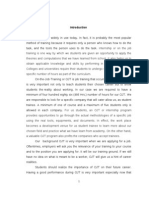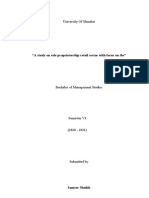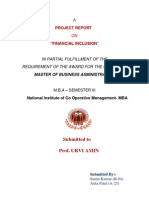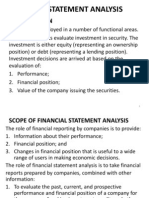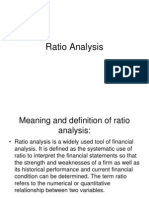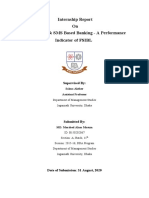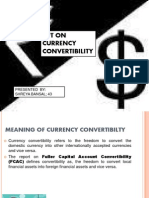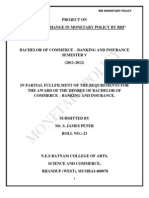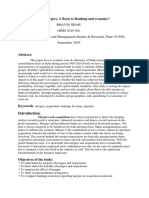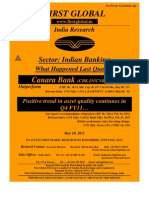0 ratings0% found this document useful (0 votes)
264 viewsRatio Analysis
Ratio Analysis
Uploaded by
Sandeep DasThis document discusses the scope, objectives, methodology, and analytical tools used in a study of the financial performance of Indusind Bank from 2010-2013. The study aims to analyze the bank's financial position, assets-liabilities structure, profitability, and overall financial performance over this time period using ratio analysis, trend analysis, and common size statement analysis of the bank's annual financial reports. The analysis is limited by the short duration of the research and inability of financial statements to disclose some impacts on profitability.
Copyright:
© All Rights Reserved
Available Formats
Download as DOCX, PDF, TXT or read online from Scribd
Ratio Analysis
Ratio Analysis
Uploaded by
Sandeep Das0 ratings0% found this document useful (0 votes)
264 views45 pagesThis document discusses the scope, objectives, methodology, and analytical tools used in a study of the financial performance of Indusind Bank from 2010-2013. The study aims to analyze the bank's financial position, assets-liabilities structure, profitability, and overall financial performance over this time period using ratio analysis, trend analysis, and common size statement analysis of the bank's annual financial reports. The analysis is limited by the short duration of the research and inability of financial statements to disclose some impacts on profitability.
Original Description:
It is the data reqired to copose ratio analysis
Copyright
© © All Rights Reserved
Available Formats
DOCX, PDF, TXT or read online from Scribd
Share this document
Did you find this document useful?
Is this content inappropriate?
This document discusses the scope, objectives, methodology, and analytical tools used in a study of the financial performance of Indusind Bank from 2010-2013. The study aims to analyze the bank's financial position, assets-liabilities structure, profitability, and overall financial performance over this time period using ratio analysis, trend analysis, and common size statement analysis of the bank's annual financial reports. The analysis is limited by the short duration of the research and inability of financial statements to disclose some impacts on profitability.
Copyright:
© All Rights Reserved
Available Formats
Download as DOCX, PDF, TXT or read online from Scribd
Download as docx, pdf, or txt
0 ratings0% found this document useful (0 votes)
264 views45 pagesRatio Analysis
Ratio Analysis
Uploaded by
Sandeep DasThis document discusses the scope, objectives, methodology, and analytical tools used in a study of the financial performance of Indusind Bank from 2010-2013. The study aims to analyze the bank's financial position, assets-liabilities structure, profitability, and overall financial performance over this time period using ratio analysis, trend analysis, and common size statement analysis of the bank's annual financial reports. The analysis is limited by the short duration of the research and inability of financial statements to disclose some impacts on profitability.
Copyright:
© All Rights Reserved
Available Formats
Download as DOCX, PDF, TXT or read online from Scribd
Download as docx, pdf, or txt
You are on page 1of 45
RESEARCH METHODOLOGY
SCOPE OF THE STUDY
The financial statements are of much interest to number of group of persons. These groups are
very much interest in the analysis of financial statement. Analysis means to put of a statement
into simple term for the benefit of a person. Ratio is a quotient of two numbers and the relation
expressed between two accounting figures is known as accounting ratio . Ratio analysis is a
very powerful analytical tool useful for measuring performance of an organization. It helps the
management to analyze the past performance of the firm and to make further projections. It
allows interested partied like share holders, investors, creditor and Government to make an
evaluation of certain aspect of a firms performance. It normally pinpoints a businesss strength
and weakness.
OBJECTIVE OF THE STUDY
The basic objective of the study was to find out the financial position and Performance of
Indusind Bank by comparing the financial reports of 2010-13 and to analyze whether the firm is
in increasing or declining trend.
The main objective of the study are:
1. To study the changes in the assets-liabilities structure of bank during the year.
2. To study the profitability and turnover position of the bank.
3. To compare the ratios of three consecutive years from 2010-13.
4. To evaluate the overall financial performance of the bank.
METHODOLOGY
RESEARCH DESIGN
The research has to use facts and information already with the institution. Financial statement of
the earlier year and analysis of these statements helps Make critical evaluation of the material,
thereby making the type of research Conducted to be analytical in nature.
NATURE AND COLLECTION OF DATA
The primary data for the study are basically secondary in nature. These were collected from the
audited annual report of the bank and other financial report of the concern.
ANALYTICAL TOOLS APPLIED
The study employs the following analytical tools:
1. Ratio analysis
2. Trend analysis
3. Common size statement analysis
LIMITATIONS
It is well known fact that constraints and limitations are bound to be present in any research. This
research has following limitations:
1. The duration of the research was two months, so in such a short span of time it was difficult
to produce accurate results.
2. Financial statements do not disclose the change in management loss of market etc. Which
have a vital impact on the profitability of the concern?
3. The research was conducted in Patna only, so the findings may not be applicable to other
region.
INTRODUCTION TO THE RATIO ANALYSIS
Theoretical Concept of financial statement analysis
Financial Statement
Financial Statement is the final product of accounting work during the year. In other words a
financial statement is the collection of data and organized in accordance with logical and
consistent accounting principles. Its purpose is to convey an understanding of financial aspect of
a business firm. It shows the financial position at a moment of time, as in case of a balance sheet,
or may be reveal a series of activities over a given period of time as in the case of an income
statement. Financial statement are the major means, through which firm present their financial
situation to stockholders, creditors, investors and the general public. The majority of firm include
extensive financial statement in their annual reports, which receive wide distribution.
The two basic financial statements prepared for purpose of external reporting to owners,
investors, creditors, and the general public are:
1. P/L A/C (or income statement )
2. Balance sheet (or statement of financial position )
The preparation of financial statement is the responsibility of top management.
Objectives
The basic objective of financial statement is to assist in decision making the various other
objectives are:-
1. To provide reliable financial information about economic resource and obligation of a
business enterprise.
2. To provide reliable information about changes in net resource of an enterprise that result from
the profit directed activities.
3. To provide financial information that assist in estimating the earning potential of the
enterprise.
Financial Statement Analysis
Financial statement analysis consist of application of analytical tools and techniques to Interpret
the data in financial statement in order to derive from them measurement and Relationship that
are significant and useful for decision making. It is the process of Identifying the financial
strengths and weakness of the firm by properly establishing Relationship between the items of
the balance sheet and the profit and loss account. Financial analysis can be undertaken by
management of the firm, or the parties outside the firm, whose interest is involved with the firm
such as owners, investors and the General public.
Nature of Financial Analysis
The nature of financial analysis will differ depending on the purpose of the analysis. For
Example, trade creditors are interested in the firms ability to meet their claims over a very short
period of time. Their analysis will, therefore confine to the evaluation of the firms liquidly
position the supplier of long term debts, on the other hand is concerned with the firm long term
solvency and survival. They analyze the firms profitability over time, its ability to generate cash
to be able to play interest and repay principal and to establish the relationship between various
sources of funds (Capital structure relationship). Long term creditors do analyze the historical
financial statements but they place more emphasis on the firms projected financial statement to
make analysis about its future solvency and profitability. Similarly, investors, who have invested
their money in the firms share or planning to invest their money in firm, are more concerned
about the firms earnings. As such they concentrate on the analysis of the firms present and
future profitability. They are also interested in the firms financial structure to extent its
influences the firms Earning ability and risk. Finally, management of the firm would be
interested in every aspects of the financial analysis. It is their overall responsibility to see that
resources of the firm are used most effectively and that the firms financial condition is sound.
Types of Financial statement analysis
1. External Analysis:-
The External analysis of financial statement is done by the outside agencies like
investors, financial analyst, lenders, government agencies, research scholars etc.
2. Internal Analysis:-
The internal analysis is done by those who have access to detailed financial records of firm
generally; management is interested in the analysis of financial statements for measuring the
effectiveness of its own policies and decisions.
3. Horizontal Analysis:-
When evaluating is done for several years simultaneously at a time for making conclusions,
it is called Horizontal Analysis. This is done for findings the trend ratio and in comparative
financial statements.
4. Vertical Analysis:-
It is the study of quantitative relationship of one financial item to another based on financial
on a particular date. Common size statement and ratio analysis are the examples of vertical
analysis.
5. Long-term Analysis:-
The long term analysis of the financial statement is done with a view to evaluate the long
term solvency, profitability, liquidity, financial health, earning capacity of the firm, debt
servicing capacity etc. of a business enterprises.
6. Short-term Analysis:-
The short term analysis is done mainly to determine the liquidity position of the firm and
short term solvency of the firm.
Methods of analyzing financial statements
The important methods used in analysis of financial statement are as follows:-
1. Comparative financial statement
Comparative financial statement are statements of financial position of a business
Designed to provide time perspective to the consideration of various elements of financial
position embodied in such statements
2. Common size statement
The figures shown in financial statement viz. profit and loss account and balance sheet
are converted to percentages so as to establish each element to the total statements is
called common size statements.
3. Trend ratio
The trend ratios of different items are calculated for various periods for comparison
purpose. The trend ratios are the index numbers of the moments of reported financial
items in the financial statements which are calculated for then one financial year.
4. fund flow analysis:-
in a fund flow analysis, the details of financial resources availed and the ways in which
such resource are used during are particular accounting period ,are given in a statement
from called fund flow statement.
5. cash flow analysis:-
Cash flow statement provides information about the cash receipt and payments of a firm
for a given period. The information about the cash flows of a firm useful in providing
users of financial statements with a basis to assess the ability of the enterprise to generate
cash and cash equivalents and the need of a enterprise to utilize these cash flows.
Ratio Analysis
Ratio analysis as a widely tool of financial analysis. It can be used to compare the risk and return
relationships of firms of different sizes. It is defined as the systematic use of ratio to interpret the
financial statements so that the strengths and the weakness of the firm as well as its historical
performance and current financial condition can be determined. The term ratio refers to the
numerical or quantitative relationship between two items/variables. The ratio reveals the
relationship in a more meaningful so as to enable equity investors, management and lenders
make better investment and credit decisions.
The rationale of ratio analysis lies in the fact that is makes related information comparable. A
single figure by itself has no meaning but when expressed in terms of a related figure, it yields
significant inferences.
Ratio analysis as extremely helpful in providing valuable insight into companys financial
picture. Ratio normally pinpoints a business strengths and weakness in two ways
Ratio provides an easy way to compare present performance with past.
Ratio depict the areas in which a particular business competitively advantaged OR
disadvantaged through comparing ratios to those of other businesses of the same size
within the same industry.
Importance of ratio Analysis
The major benefits arising from ratio analysis are as follows:-
Ratio analysis is a very powerful analytical tool useful for measuring performance of
an organization.
Ratio analysis concentrates on the inter relationship among the figures appearing the
financial statements.
Ratio analysis helps the management to analyze the past performance of the firm and
to make further projections.
Ratio analysis allows the interested parties to make evaluation of certain aspects of
the firms performance as the given below:-
1. Shareholders and prospective investors will analyze ratios for taking
investment and disinvestment decisions.
2. Bankers who provide working capital will analyze ratios for appraising the
credit worthiness of the firm.
3. The financial institutions who provide long term debt will analyze ratio for
project appraisal and debt servicing capacity of the firm.
4. The financial analysts will analyze ratio for making comparison and
recommending to the investing people.
5. The credit rating agencies will analyze ratio of a firm to five the credit rating
to the firm.
6. The government agencies will analyze ratio of a firm for review of its
performance.
The companys management will analyze ratios for determining the financial health and its
profitability.
Types of ratios
1. Liquidity ratios.
2. Leverage ratios.
3. Assets Management Ratios.
4. Profitability Ratios.
5. Operating Ratios.
6. Market based Ratios.
(1) LIQUIDITY RATIOS
The liquidity ratios measure the liquidity of the firm and its ability to meet its maturing short
term obligations. Liquidity defined as the ability to realize value in money, the most of
liquidity of assets. It refers to the ability to pay in cash, the obligations that are due.
1. Current ratio
This ratio measures the solvency of the company in the short term. Current assets are those
assets which can be converted into cash within a year. Current liability and provisions are
those liabilities that are payable within the year.
Current assets, Loan and Advances
Current liabilities and provisions
2. Quick Liquid / Acid Test Ratio
Quick ratio is used as a measure of the companys ability to meet its current obligations.
Since bank overdraft is secured by the inventories, the other current assets must be sufficient
to meet other current liabilities.
Current assets, Loan and Advances Inventories
Current liabilities and provisions Bank overdraft
3. Absolute Liquid / Super Quick Ratio
It is ratio of absolute liquid assets liabilities. However, for calculation purposes, it is taken as
ratio of absolute liquid assets to current liabilities. Absolute liquid assets include cash in
hand, cash bank and short-term or temporary investments.
Absolute Liquid Assets
Current Liabilities
4. Defensive Interval Ratio
A firm ability to meet current financial obligation is dependent on the ability to generate
daily cash requirements of firm. The defensive- internal ratio is a measure of liquidity by
comparing the liquid assets against projected daily cash requirements.
Liquid Assets
Projected Daily Cash Requirements.
(2) LEVERAGE RATIOS
The Long-term financial stability of the firm may be considered as dependent upon its ability
to meet all its liabilities, including those not currently payable. The ratios which are
important in measuring the financial leverage of the company is as follows:-
1. Debt-Equity Ratio / Solvency Ratio
This ratio indicates the relationship between loan funds and net worth of the company, which
has known as gearing. If the proportion of debt to the equity is low, a company is said to be
low-geared, and vice- versa.
Long-term Debt Secured Loan + Unsecured loans
Equity + preferences equity share capital + Share application money +
Preference share capital + reserves + surplus
2. Shareholders equity ratio
In this ratio the relationship is established between the shareholders fund and the total
assets. Shareholders fund represents equity and preference capital plus reserves and
surplus less accumulated losses. This ratio indicates the degree to which unsecured
creditors are protected against loss in the event of liquidification. It is assumed that large
the proportion of the shareholders equity, the stronger is the financial position of the
firm.
Shareholders Equity
Total Assets (tangible)
3. Long-term Debt to shareholders Net Worth Ratio
This ratio would be of more interest to the contributories of long-term finances to the
firm, as the ratio given the factual idea of the assets available to meet the long-term
liability.
Long-Term Debt
Shareholders Net Worth
4. Capital Gearing Ratio
It is the proportion of fixed interest bearing funds to equity shareholders funds. The
fixed interest bearing funds include debentures, long-term loans an preference share
capital. Capital gearing ratio indicates the degree of vulnerability of earnings available
for equity shareholders.
Fixed Interest Bearing Fund Secured Loans
=
Equity Shareholders Fund Equity share capital + Share application money +
Preference share capital + reserves + surplus
5. Fixed Assets to Long-Term Funds Ratio
This ratio indicates the proportion of the long-term funds deployed in fixed assets. Fixed
assets represent the gross fixed assets minus depreciation. Long-term funds include share
capital, reserves and surplus and long-term loans.
Fixed Assets
Long-Term Funds
6. Proprietary Ratio
It the express the relationship between shareholderss net worth and total assets. Worth
includes equity share capital, preference share capital, reserves minus fictitious assets.
Total assets include fixed assets, current minus fictitious assets.
Shareholder Net Worth
Total assets
7. Interest Cover
The interest coverage ratios show how many interest changes are covered by fund those
are available for payment of interest.
Profit before Interest, Depreciation and Tax
Interest
8. Debt Service Coverage Ratio
This ratio is the key indicator to lender to assess the of ability of the borrower to service
the loan in regard to timely payment of interest and repayment of loan instalment. The
ratio is calculated as follows:-
Profit after taxes + Depreciation + Interest on Loan
Interest on Loan + Loan Repayment in a year
9. Dividend Cover
The ratio includes the number of times the dividends are covered by net profit. This
highlights the amount retained by a company for financing of future operations.
(a) Preference Dividend Cover
Net profit after tax
Preference dividend
(b) Equity Dividend Cover
Net profit after tax Preference Dividend
Equity Dividend
(3) ASSETS MANAGEMENT RATIOS
Assets management ratios measure how effectively the firm employ its resources. These
ratios are called activity or turnover ratios which involve compassion between the level
of the sales and investments in various accounts inventories, debtors, fixed assets, etc.
Assets management ratios are used to measures the speed with which various accounts
are converted into sales or cash.
1. Inventory Turnover Ratio
The inventory turnover ratio measures how many times a companys inventory has
been sold during the year. If the inventory turnover ratio has decreased from past, it
means that either inventory is growing or sale are dropping. It is important to ensure
that the level of stocks is kept as low possible, consistent with the need to fulfill
customer orders in time.
Cost of goods sold Sales
Average Inventory Average Inventory
2. Debtors Turnover Ratio
Debit turnover, which measures whether the amounts of reasonable and whether the
company is efficient in covering debtors into cash. The higher the ratio, the better the
position.
Credit Sales
Average debtors
3. Debtors collection Period
Average debtors collection period measures how long it takes to collect amounts from
debtors.
Average Debtors 365
Credit Sales
4. Bad Debts to Sales Ratio
It measures the proportion of bad to sales. This ratio indicated the efficiently of the
credit control procedures of the company.
Bad Debts 100
Sales
5. Creditor Turnover Ratio
The term creditor includes trade creditors and bill payable.
Credit Purchases
Average Creditors
6. Creditor Payment Period
The measurement of the ratio credit turnover period shows the average time taken to
pay for goods and services purchase by the company.
Average Creditors 365
Credit purchase
7. Fixed asset Turnover Ratio
An increase in the fixed assets figure may result from the replacement of an assets at
an increased price of the purchase of an additional assets intended to increase
production capacity.
Sales
Fixed Assets
8. Total Assets Turnover Ratio
This ratio indicates the number of times of total assets is being turnover in a year.
Sales
Total Assets
9. Working Capital Turnover Ratio
This ratio indicates the extent of working capital turned ratio in achieving sales of the
firm.
Sales
Working capital
10. Sales to Capital Employed Ratio
This ratio indicates efficiency in utilization of capital employed in generating
revenue.
Sales
Capital Employed
(4) PROFITABILITY RATIO
The purpose of study and analysis of profitability ratio are to help assessing the adequacy
of profits earned by the company and also to discover whether profitability is increasing
of declining. The profitability ratios show the combined effect the liquidity, asset
management and debt management on operating results.
1. Gross Profit Margin
The ratios measure the gross profit margin on the total net sales made by the
company. The gross profit represent the excess of sales proceed during the period
under observation over the cost, before taking into account administrative, selling and
distribution financing charges.
Gross Profit 100
Sales
2. Net Profit Margin
The ratio is designed to focus attention on the net profit margin arising from business
operations before interest and tax is deducted. The convention is to express profit
after tax and interest as a percentage of sales.
Net Profit before Interest and Tax 100
Sales
3. Cash Profit Ratio
Cash profit ratio measure the cash generation in the business as a result of the
operation expressed in terms of sales.
Cash Profit 100
Sales
Cash profit = Net profit + Deprecation
4. Return on Total assets
The profitability of the firm is measured by establishing relation of net profit with the
total assets of organization. This ratio indicates the efficiency of utilization of assets
in generating revenue.
Net Profit after Tax 100
Total Assets
5. Return on Total Assets
This ratio expresses the net profit in term equity shareholders funds. This ratio is an
important yardstick of performance of equity shareholders since it indicates the return
on the fund employed by them.
Net Profit after Interest and Tax 365
Net Wroth
6. Return on Capital Employed (ROCE)
This ratio is also called as turn of investment (ROI). The strategic aim of a business
enterprise is to earn a return on the capital. Measuring the historical of an investment
centre calls for a comparison of the profit that has been earned with capital employed.
The rate of return on investment is determined by dividing net profit or income by the
capital employed or investment made to achieve that profit.
ROI consists of two components viz. (a) Profit Marin (b) Investment Turnover
Net Profit OR
Capital Employed
Net Profit sales
Sales Capital Employed
(5) OPERATING RATIOS
The ratio of all operating expenses (i.e. materials used, labour, factory overheads,
administrating and selling expenses) to sale the operating ratio. A comparison of the
operating ratio would indicate whether the cost content is high of low in the figure of
sales. If the annual comparison shows that the sale has the increased the management
would be naturally interested and concerned to know as to which elements of the cost has
gone up. A dynamic management should be interested in making a complete analysis. It
is, therefore, necessary to break up the operating ratio into various cost ratios. The major
components of cost are: Materials, labour and overheads.
(a) Material Cost Ratio
Material Consumed 100
Sales
(b) Labour Cost Ratio
Labour Cost 100
Sales
(c) Factory Overhead Ratio
Factory expenses 100
Sales
(d) Administrative Expenses Ratio
Administrative Expenses 100
Sales
(e) Selling and Distribution Expenses Ratio
Selling and Distribution Expenses 100
Total Assets
(f) Operating Ratio
Cost of Goods Sold + Operating Expenses 100
Net Sales
(6) MARKET BASED RATIO
The market based ratio relates the firms stock price to its earnings and book value per
share. These ratio given management and indication of what investors think of the
companys past performance and future prospects. If firms profitability, solvency and
turnover ratio are good, them the market based ratio will be high and share price is also
expected to be high. The market based ratios are as follows
1. The objective of financial management is wealth or value maximization of a
corporate entity. In practice, the performance of a corporation is better judged in term
of its earnings per share (EPS). The EPS is one of the important measures of the
economic performance of a corporate entity. The flow of capital to the companies
under the present imperfect capital market conditions would be made on the
evaluation of EPS. Investor lacking inside and detailed information would look upon
the EPS as the best base to take their investment decisions. A higher EPS means
better capital productivity.
Net Profit after Tax and Preference Dividend
No. of Equity shares
EPS is one of the most important ratios which measure the net profit earned per share.
EPS is one of the major factor affecting the dividend policy of the firm an the market
prices of the company.
2. Cash Earnings Per Share
The cash earnings per share (Cash EPS) are calculated by dividing the net profit
before depreciation with number of equity shares.
Net Profit after Tax + Depreciation
No. of equity shares
This measure cash earnings per share and is also relevant factor for determining the
price for the companys shares.
3. Dividend Payout Ratio
Dividend payout ratio is the dividend per share. Dividend payout indicated the extent
of the profits distributed to the shareholder as dividend.
Dividend per Share
Earnings per Share
4. Dividend yield
This ratio reflects the percentage yield that an investor receives pm this investment at
the current market price of the shares.
Dividend per Share 100
Market Price
5. Book Value
This ratio indicates the net worth per equity share. The book value is a reflection of
the past earnings and the distribution policy of the company. A high book value
indicates that a company has huge reserve and is a potential bonus candidate. A low
book value signifies a liberal distribution policy of bonus and dividends.
Equity Capital + Reserves Profit and Loss A/C Debit balance
Total no. of Shares
6. Price Earnings Ratio (P/E Ratio)
This ratio indicates the market price of an equity share earnings per share. It measures
the number of time the earnings per share discount the market prices of an equity
share.
Current Market price of Equity Share
Earnings per Share
The ratio indicates how much an investor is prepared to pay per rupees of earnings.
The ratio help to ascertain the value of equity share.
7. Market Price to Book Value Ratio (P/BV Ratio)
This ratio measures the relationship between the accounting value of firms assets and
the market price of its stock. The ratio is calculated by dividend the stock price per
share by the book value share.
Market Prices per Share
Book Value per Share
Generally, the higher the rate of return of firm earnings on its common equity the
higher will be the P/BV ratio.
ANALYSIS AND INTERPRETION
LIQUIDITY RATIO
Current Ratio
The current ratio is the ratio of total current assets to total current liabilities. It indicated the
short-term financial soundness of the bank. It judges whether current asset are sufficient to meet
the current liabilities.
Accounting to convention, current ratio is supposed to be 1.33 for the banks.
Current Asset
Current liabilities
2004-05 2005-06 2006-07 2007-08 2008-09 2009-10
Current Assets 2678.72 3039.54 3890.54 4343.64 147655.24 5164.97
Current
liabilities
4439.32 4445.61 5659.97 7244.26 147655.22 5545.27
CR 0.60 0.68 0.69 0.60 0.49 0.97
Current ratio shows increasing tend up to financial year 2006-07 and shows decrease in financial
year 2007-08. This is symptom of financial distress. Also it is not up to conventional 1.33 CR for
banks.
LIQUIDITY RATIO
0
0.1
0.2
0.3
0.4
0.5
0.6
0.7
0.8
0.9
1
2004-05 2005-06 2006-07 2007-08 2008-09 2009-10
0.62
0.68
0.69
0.6
0.49
0.97
CR
CR
QUICK RATIO
This ratio shows the ability of a firm to meet its immediate commitment without relying on the
sale and collection of inventories. It is used to supplement the information given by the current
ratio. This ratio is also known as Acid Test Ratio or Liquid Ratio.
Liquid Assets
Current Liabilities
2004-05 2005-06 2006-07 2007-08 2008-09 2009-10
Liquid Assets 35514.56 43922.63 61184.28 88887.0 101112.78 127541.21
Current
Liabilities
4439.32 4445.61 5659.97 7244.26 9167.07 5545.27
Quick Ratio 8.00 9.88 10.81 12.27 11.03 23
QUICK RATIO
0
5
10
15
20
25
2004-05 2005-06 2006-07 2007-08 2008-09 2009-10
8
9.88
10.81
12.27
11.03
23
QUICK RATIO
QUICK RATIO
LEVERAGE RATIO
Debt-equity Ratio
The debt equity ratio is the ratio of the total debt in the firm (both long term) to equity, where
equity is the sum of ordinary share capital and preferential capital.
Secure loan + unsecured loan
Equity share capital + Share application money
Preference share capital + reserves & surplus
2004-05 2005-06 2006-07 2007-08 2008-09 2009-10
Debt 60751.67 66482.65 82776.28 110319.67 174933.30 172748.69
Equity 2741.65 2934.33 3303.98 3904.09 4613.22 4610.32
Ratio 22.16 22.66 25.06 28.26 37.92 37.47
Better financial position shown by banks.
LEVERAGE RATIO
0
5
10
15
20
25
30
35
40
2004-05 2005-06 2006-07 2007-08 2008-09 2009-10
22.16
22.66
25.06
28.26
37.92
37.47
RATIO
RATIO
FIXED ASSETS TURNOVER RATIO
The fixed assets turnover ratio measure the efficiency with which the firm is utilizing its
investment in fixed assets such as land & building, plant & machinery, furniture and fixtures etc.
It also indicated of sales in relation to investment in fixed assets.
Sales
Fixed assets
2004-05 2005-06 2006-07 2007-08 2008-09 2009-10
Sales 5204.87 5385.58 6234.21 7995.54 8268.57 8950.12
Fixed Assets 1213.26 1420.9 1436.9 2961.3 2056.86 2521.16
F.A.T.R 4.29 3.79 4.34 2.70 4.02 3.55
FXIED ASSETS TURNOVER RATIO
0
0.5
1
1.5
2
2.5
3
3.5
4
4.5
2004-05 2005-06 2006-07 2007-08 2008-09 2009-10
4.29
3.79
4.34
2.7
4.02
3.55
F.A.T.R.
F.A.T.R.
PROFITABILITY RATIO
Operating Profit Margin
This ratio indicates the operation profit margin on the total net sales made by the bank.
Operating profit 100
Sale
2004-05 2005-06 2006-07 2007-08 2008-09 2009-10
Operating profit
(in crore)
2499.42 2950.62 3979.45 5833.35 2192.65 2712.72
Sales (in crore) 5204.87 5385.85 6234.21 7995.54 4182.59 15454.70
POM (%) 48.2 52.93 63.83 72.96 52.42 17.55
Operating profit ratio more than normal rate of return on sales. So that indicated better
performance by bank.
PROFITABILITY RATIO
0
10
20
30
40
50
60
70
80
2004-05 2005-06 2006-07 2007-08 2008-09 2009-10
48.2
52.93
63.83
72.96
52.42
17.55
OPM(%)
OPM(%)
GROSS PROFIT RATIO
This ratio related gross profit to sales to indicate gross margin on sale and is expressed as
percentage. It may be used as on indicator of the efficiency of the production and the relation
between production and the relation between production cost and selling price.
Gross Profit 100
Net Sales
2004-05 2005-06 2006-07 2007-08 2008-09 2009-10
Gross Profit(in
crore)
5204.87 5385.58 6234.21 7995.54 9151.70 11068.55
Net Sales(in
crore)
1609.17 1194.67 1265.72 1268.30 118239.01 108831.37
GPM (%) 5.84 4.35 7.42 6.26 7.74 10.17
GROSS PROFIT RATIO
0
2
4
6
8
10
12
2004-05 2005-06 2006-07 2007-08 2008-09 2009-10
5.84
4.35
7.42
6.26
7.74
10.17
GPM(%)
GPM(%)
PAY OUT RATIO
Dividend payout ratio
This ratio indicates the extent of the net profit distributed to the shareholder as dividend. A high
payout signifies a liberal distribution high payout signifies a liberal distribution policy and a low
payout reflects conservation distribution policy.
Dividend per share
Earning per share
2004-05 2005-06 2006-07 2007-08 2008-09 2009-10
Dividend per
share
35.49 50.70 358.34 301.73 290.46 550.62
EPS 3.18 2.29 15.36 13.61 12.45 24.87
DPR 11.16 22.14 23.33 22.17 23.33 22.14
DIVIDEND PAYOUT RATIO
0
5
10
15
20
25
2004-05 2005-06 2006-07 2007-08 2008-09 2009-10
11.16
22.14
23.33
22.17
23.33
22.14
DPR
DPR
Dividend Cover ratio
This ratio indicates the number of time the dividends are covered by net profits. This highlights
the amount retained by a company for financing of future operations.
(a) Preference dividend cover
Net profit after tax
Preference dividend
2004-05 2005-06 2006-07 2007-08 2008-09 2009-10
NAT 464.44 328.55 498.30 550.62 573 583
Preference
dividend
_ _ 0.19 70.00 68.40 53.09
P D C _ _ 2622.6 7.866 8.42 10.98
PREFERANCE DIVIDENDRATIO
0
500
1000
1500
2000
2500
3000
2004-05 2005-06 2006-07 2007-08 2008-09 2009-10
0 0
2622.6
7.866 8.42 10.98
PCD
PCD
(b) Equity dividend cover
Net profit after tax - Preference dividend
Equity dividend
2004-05 2005-06 2006-07 2007-08 2008-09 2009-10
NAT-PD - - 489.11 480.62 474 483
Equity dividend 35.00 50.00 99.41 80.83 63.97 63.30
EDC - - 5.01 5.95 7.41 7.63
EQUITY DIVIDEND COVER RATIO
0
1
2
3
4
5
6
7
8
2004-05 2005-06 2006-07 2007-08 2008-09 2009-10
0 0
5.01
5.95
7.41
7.63
EDC
EDC
Interest Cover Ratio
This ratio show how many time interest changes are covered by fund that is available for
payment of interest. A very high ratio indicates that the firm is conservation in using debt and
very low ratio indicates excessive use of debt.
Profit before interest /depreciation and tax
Interest
2004-05 2005-06 200607 2007-08 2008-09 2009-10
PBDIT(in crore) 856.64 561.78 644.76 979.15 1107.83 1784.40
Interest 2829.93 3005.51 3759.79 5772.48 460.35 713.76
ICR 0.30 0.19 0.17 0.17 2.4 2.5
INTEREST COVERAGE RATIO
0
0.5
1
1.5
2
2.5
2004-05 2005-06 2006-07 2007-08 2008-09 2009-10
0.3
0.19
0.17 0.17
2.4
2.5
ICR
ICR
EARNING PER SHARE
The profitability of a firm from the point of view of ordinary shareholder can be measured in
term of number of equity shares. This is known as EPS. A higher EPS means better capital
productivity.
Net profit after tax & preference dividend
No. Of equity share
2004-05 2005-06 2006-07 2007-08 2008-09 2009-10
Net profit (in
gross)
357.41 257.42 498.01 550.16 571 668
No. of equity
share
404139460 404139460 404139460 404139460 404139460 404139460
EPS(Rs) 3.18 2.29 15.36 13.61 12.46 24.88
EARNING PER SHARE
0
5
10
15
20
25
2004-05 2005-06 2006-07 2007-08 2008-09 2009-10
3.18
2.29
15.36
13.61
12.46
24.88
EPS(Rs)
EPS(Rs)
CASH EARNING PER SHARE
This is more reliable yardstick for measurement of performance of companies, especially for
highly capital intensive where provision for depreciation is substantial. This measures the cash
earnings per share and is also a relevant factor for determining the price for the companys share.
It is used as a supplementary measure of performance only.
Net profit after tax + depreciation
No. of equity shares
2004-05 2005-06 2006-07 2007-08 2008-09 2009-10
NPAT + Dep.(in
crore)
520.61 379.45 563.3 624.23 571.24 1058.25
No. of equity
share
4041399460 404139460 404141460 404141460 404139460 404139460
Cash EPS 12.88 9.39 13.93 15.45 14.58 26.83
CASH EPS
0
5
10
15
20
25
30
2004-05 2005-06 2006-07 2007-08 2008-09 2009-10
12.88
9.39
13.93
15.45
14.58
26.83
CASH EPS
CASH EPS
You might also like
- Shareholder Agreement TemplateDocument5 pagesShareholder Agreement TemplateBelteshazzarL.Cabacang100% (2)
- Financial Analysis and Decision Making PowerpointDocument28 pagesFinancial Analysis and Decision Making Powerpointashvina321No ratings yet
- Mba Dissertation On Banking SecurityDocument78 pagesMba Dissertation On Banking Securitychada12345No ratings yet
- Asset and Liability Management in BanksDocument73 pagesAsset and Liability Management in Banksshirishgoyal4100% (1)
- SWIFT Message To Initiate A Banking TransactionDocument3 pagesSWIFT Message To Initiate A Banking TransactionAboHsain AlshaikhNo ratings yet
- Narrative Report (PNB)Document16 pagesNarrative Report (PNB)Rhea Hubo Fajardo93% (15)
- Impact of Globalization On Strategic ManagementDocument9 pagesImpact of Globalization On Strategic ManagementzaidkhanNo ratings yet
- Ratio Analysis Notes - SATANDocument26 pagesRatio Analysis Notes - SATANinsomniac_satanNo ratings yet
- Impact of Monetary Policy On Indian IndustryDocument13 pagesImpact of Monetary Policy On Indian IndustryVikalp Saxena50% (2)
- Banking and Finance Project TopicsDocument4 pagesBanking and Finance Project Topicskelvin carterNo ratings yet
- Money Supply in India 1Document9 pagesMoney Supply in India 1Chaitanya ChoudharyNo ratings yet
- Comparative Financial Analysis On Sbi Life Insurance & Icici Prudential Life InsuranceDocument62 pagesComparative Financial Analysis On Sbi Life Insurance & Icici Prudential Life InsuranceNeha KumariNo ratings yet
- Project Work On Bisleri.Document60 pagesProject Work On Bisleri.Rizwan Shaikh 44No ratings yet
- A Financial Statement Analysis ProjectDocument14 pagesA Financial Statement Analysis ProjectJibin Raju100% (1)
- Financial Ratio AnalysisDocument23 pagesFinancial Ratio AnalysisAnkita SharmaNo ratings yet
- Financial InclusionDocument46 pagesFinancial Inclusionsumitkjham50% (4)
- 19 Arid 3523Document2 pages19 Arid 3523Ahmer AshrafNo ratings yet
- Financial Statement Analysis Second LectureDocument20 pagesFinancial Statement Analysis Second LectureDavid Obuobi Offei KwadwoNo ratings yet
- Portfolio RevisionDocument21 pagesPortfolio RevisionShihab PvrNo ratings yet
- Indian Banking SystemDocument42 pagesIndian Banking Systemdraun vashishtaNo ratings yet
- Credit Management of RetailersDocument35 pagesCredit Management of Retailershemal dhuriNo ratings yet
- Monetary PolicyDocument10 pagesMonetary PolicyAshish MisraNo ratings yet
- Ratio AnalysisDocument26 pagesRatio AnalysisPratibha ChandilNo ratings yet
- Central Bank InterventionDocument31 pagesCentral Bank InterventionmilktraderNo ratings yet
- Importance of Banks in An EconomyDocument3 pagesImportance of Banks in An EconomyfinkeeffacolegeNo ratings yet
- Synopsis Ratio AnalysisDocument2 pagesSynopsis Ratio Analysismoshiurrah0% (2)
- Bop & International Economics LinkagesDocument77 pagesBop & International Economics LinkagesGaurav Kumar100% (2)
- 3P - Finance With Other DisciplinesDocument2 pages3P - Finance With Other DisciplinesRaju RajendranNo ratings yet
- Question: What Are The Functional Areas Of: Financial Management?Document3 pagesQuestion: What Are The Functional Areas Of: Financial Management?Madhubala SinghNo ratings yet
- Ratio AnalysisDocument4 pagesRatio AnalysisdattacuriousNo ratings yet
- The Impact of Monetary Policy On The Performance of Banking IndustryDocument75 pagesThe Impact of Monetary Policy On The Performance of Banking IndustryGreatman0% (1)
- Risk Management NotesDocument1 pageRisk Management NotesViraja GuruNo ratings yet
- A Study On Investment Preference and Behaviour of Individual Investors in Coimbatore CityDocument5 pagesA Study On Investment Preference and Behaviour of Individual Investors in Coimbatore CityBONFRING0% (1)
- Multiplier Approach To Share ValuationDocument2 pagesMultiplier Approach To Share ValuationI am IndianNo ratings yet
- Determinants of Financial StructureDocument15 pagesDeterminants of Financial StructureAlexander DeckerNo ratings yet
- New Non Banking Financial InstitutionsDocument18 pagesNew Non Banking Financial InstitutionsGarima SinghNo ratings yet
- Ratio AnalysisDocument48 pagesRatio AnalysisAadesh ShahNo ratings yet
- Chapter - Monetary Policy (Model & Transmission) 1Document4 pagesChapter - Monetary Policy (Model & Transmission) 1Nahidul Islam IUNo ratings yet
- Internship Report On FSIBL Cloud & SMS Based Banking - A Performance Indicator of FSIBLDocument22 pagesInternship Report On FSIBL Cloud & SMS Based Banking - A Performance Indicator of FSIBLnahidNo ratings yet
- Central BankDocument9 pagesCentral BanksakibNo ratings yet
- Financial Literacy: An Essential Tool To Regain Confidence in The Financial Services IndustryDocument77 pagesFinancial Literacy: An Essential Tool To Regain Confidence in The Financial Services IndustryStefan LiaNo ratings yet
- Nestle India - Forex RisksDocument14 pagesNestle India - Forex RisksTania Sethi100% (1)
- Financial Management Assignment ReportDocument16 pagesFinancial Management Assignment Reportaddyie_26509406591% (22)
- Canara BankDocument15 pagesCanara BankeswariNo ratings yet
- Strategy and Efforts of A Public Sector Bank For Financial InclusionDocument10 pagesStrategy and Efforts of A Public Sector Bank For Financial InclusionKhushi PuriNo ratings yet
- A Study On Asset Liability ManagementDocument56 pagesA Study On Asset Liability ManagementMisraNo ratings yet
- On Currency ConvertibilityDocument19 pagesOn Currency ConvertibilityShreya Saransh Goel100% (1)
- Asset-Liability-Management - A Comparative Study of A Public andDocument10 pagesAsset-Liability-Management - A Comparative Study of A Public andsukanyaNo ratings yet
- Certainty Equivalent FactorDocument2 pagesCertainty Equivalent FactorParth SahniNo ratings yet
- Introduction of MNC'SDocument48 pagesIntroduction of MNC'SMitali AmagdavNo ratings yet
- Financial Statement Analysis-Indian BankDocument74 pagesFinancial Statement Analysis-Indian Bankharpreet kaurNo ratings yet
- Working Capital AnalysisDocument20 pagesWorking Capital Analysisaneek100% (1)
- Executive SummaryDocument4 pagesExecutive SummaryDebashish MazumderNo ratings yet
- Axis BankDocument28 pagesAxis BankRahul ManwaniNo ratings yet
- COMPARATIVE STUDY OF BROADBAND SERVICES OF TELECOM SECTOR" WPDocument75 pagesCOMPARATIVE STUDY OF BROADBAND SERVICES OF TELECOM SECTOR" WPBhavesh GajeraNo ratings yet
- Case Study MNC PDFDocument19 pagesCase Study MNC PDFAlamSyahNo ratings yet
- Presentation On Ratio Analysis:: A Case Study On RS Education Solutions PVT - LTDDocument12 pagesPresentation On Ratio Analysis:: A Case Study On RS Education Solutions PVT - LTDEra ChaudharyNo ratings yet
- Roll of Accounting Standards and AuditingDocument47 pagesRoll of Accounting Standards and AuditingRishabh PandeyNo ratings yet
- Effective Interest RateDocument4 pagesEffective Interest RateJoseph WongNo ratings yet
- Monetary Policy of Rbi........... (James)Document56 pagesMonetary Policy of Rbi........... (James)James Peter100% (2)
- Bank MergersDocument6 pagesBank MergersBhavin shahNo ratings yet
- Financing Small and Medium-Sized Enterprises in Asia and the Pacific: Credit Guarantee SchemesFrom EverandFinancing Small and Medium-Sized Enterprises in Asia and the Pacific: Credit Guarantee SchemesNo ratings yet
- The Cost of Capital: Sources of Capital Component Costs Wacc Adjusting For Flotation Costs Adjusting For RiskDocument37 pagesThe Cost of Capital: Sources of Capital Component Costs Wacc Adjusting For Flotation Costs Adjusting For RiskMohammed MiftahNo ratings yet
- 3rd Sem ReportDocument62 pages3rd Sem ReportJose AntonyNo ratings yet
- 107 19 Snap ValuationDocument21 pages107 19 Snap ValuationDavid Chikhladze0% (1)
- Single 287967086580186410492Document13 pagesSingle 287967086580186410492carlNo ratings yet
- Full Theory Ca Final SFM by Aaditya Jain SirDocument127 pagesFull Theory Ca Final SFM by Aaditya Jain SirVijayaNo ratings yet
- Logical Reasoning 2Document2 pagesLogical Reasoning 2luigimanzanaresNo ratings yet
- 25 Stock Transfer & Transfer PostingDocument14 pages25 Stock Transfer & Transfer PostinglymacsauokNo ratings yet
- Philippine Institute of Certified Public Accountants (PICPA)Document2 pagesPhilippine Institute of Certified Public Accountants (PICPA)Jeaneth Dela Pena Carnicer100% (2)
- Sample MC QuestionsDocument11 pagesSample MC QuestionskarynNo ratings yet
- Barron's Interview With Ray Dalio, Bridgewater Associates (2009) - Recession? No, It's A Process, and It Will Be LongDocument5 pagesBarron's Interview With Ray Dalio, Bridgewater Associates (2009) - Recession? No, It's A Process, and It Will Be Longzara.tuilbaud100% (12)
- Final Project FinanceDocument25 pagesFinal Project Financetanishka k0% (1)
- Strong Performers - High DVM StocksDocument8 pagesStrong Performers - High DVM StocksAbhishek Michael ChandNo ratings yet
- The Power of The ST50 List - IVANHOFFDocument13 pagesThe Power of The ST50 List - IVANHOFFJuan CalfunNo ratings yet
- Investment Banking KnowledgeDocument7 pagesInvestment Banking Knowledge1raju1234100% (1)
- S C Volume The Forgotten Oscillator PDFDocument6 pagesS C Volume The Forgotten Oscillator PDFkosurugNo ratings yet
- Business Associations OutlineDocument52 pagesBusiness Associations OutlineChi Wen YeoNo ratings yet
- SOA MailFile 128 181800292Document7 pagesSOA MailFile 128 181800292s.suresh k.swaminathanNo ratings yet
- De Los Santos Vs Attorney GeneralDocument2 pagesDe Los Santos Vs Attorney GeneralEM RGNo ratings yet
- Tunneling or Proppingevidence From ChinaDocument40 pagesTunneling or Proppingevidence From ChinadependNo ratings yet
- Question Paper Design Accountancy (Code No. 055) Class XII (2014-15) March 2015 ExaminationDocument9 pagesQuestion Paper Design Accountancy (Code No. 055) Class XII (2014-15) March 2015 ExaminationBharat BhushanNo ratings yet
- Super Trend Backtesting ResultDocument28 pagesSuper Trend Backtesting ResultJohnny ChakoNo ratings yet
- Trading Power Trends With ADX by DRDocument6 pagesTrading Power Trends With ADX by DRpaoloNo ratings yet
- Legal Aspect of BusinessDocument146 pagesLegal Aspect of Businesssumitkjham100% (1)
- Analysis of The Sec's Proposed Climate Disclosure RulesDocument8 pagesAnalysis of The Sec's Proposed Climate Disclosure RulesSteveNo ratings yet
- First Global: Canara BankDocument14 pagesFirst Global: Canara BankAnkita GaubaNo ratings yet
- In Re Pacl Limited and Ors 02022016 Sebi SatDocument47 pagesIn Re Pacl Limited and Ors 02022016 Sebi SatJai VermaNo ratings yet





